What is leadership and management in nursing practice?
Leadership and management are two critical components in the healthcare industry. They are the driving force behind the success and quality of healthcare delivery.
The roles of leaders and managers are similar and run parallel to each other. They have distinct responsibilities and functions that contribute to the overall operation of a healthcare organization.
Effective nursing leadership involves motivating and inspiring others towards a common goal by establishing a collaborative, innovative, and continuously improving environment.
The role of a nursing leader extends beyond providing direct patient care; they also guide other healthcare professionals for quality patient care and participate in shaping healthcare policies.
Management in nursing practice encompasses the organizational and administrative aspects of nursing. It involves planning, organizing, directing, controlling, and coordinating the delivery of healthcare services.
Effective management is crucial for the efficient and effective utilization of resources to provide optimal patient care.
Leadership and management skills empower nurses to advocate for patients’ rights, guide their teams, and contribute to organizational goals. Moreover, these roles empower nurses to bring change in healthcare systems and improve patient outcomes.
Click to read complete article on legal aspects of nursing documentation
Difference between leadership and management
The difference between leadership and management is nuanced yet significant. Both are crucial for the effective functioning of any organization, but they entail different responsibilities, skills, and approaches.
1. Leadership
- Leadership often requires a visionary approach, the ability to inspire and motivate, and a focus on people and relationships.
- Leaders inspire with a shared vision and rally their teams around a common cause, fostering creativity and encouraging individual growth.
- Leadership is about impressing others to achieve a common goal.
- Leaders typically are the ones who initiate and drive change within an organization. They have a forward-looking view and strategize for future challenges and opportunities.
- A leader inspires and motivates their team to reach their full potential.
- Leaders do not necessarily adhere strictly to rules or policies but use innovative thinking to guide their actions.
- Leaders have a vision for the future and work towards turning it into reality.
- Leaders foster an environment that encourages growth, creativity, and innovation.
- Leaders exhibit an influential style of working and are often admired for their charisma, passion, and ability to empower others.
- Leaders are more people-oriented; they understand the strengths and weaknesses of their team members and encourage them to perform at their best.
- Leaders inspire growth, innovation, and change.
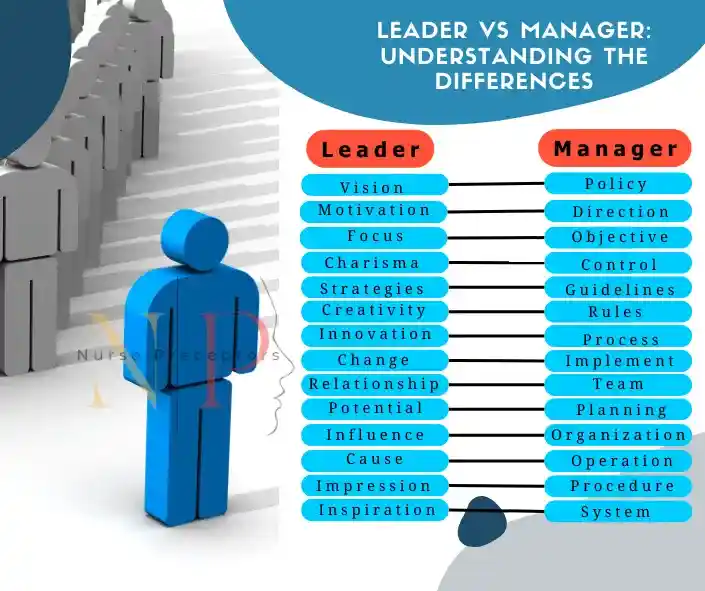
2. Management
- Management involves control and problem-solving within a structured environment.
- Managers often possess a directive style of working, establishing detailed strategies and ensuring their team follows them meticulously.
- Management is more focused on systems, processes, and achieving defined objectives.
- Managers focus on planning, setting, measuring, and achieving goals.
- Managers control situations to reach or exceed their objectives, often through policies and procedures.
- Managers often deal with implementing changes.
- Managers ensure that daily operations align with the organization’s broader goals.
- A manager primarily focuses on operations, ensuring the smooth functioning of a team or a business.
- A manager’s role is often associated with planning, organizing, coordinating, and controlling.
- Managers work by the book, adhering strictly to rules and guidelines set by the organization.
- Managers focus on meeting set goals and targets, using their resources most efficiently to achieve desired results.
- Managers ensure stability and efficiency in day-to-day operations.
7 Theories of leadership and management
Theories of leadership and management have evolved to adapt to the shifting business landscapes and societal norms. These theories of leadership and management offer different perspectives on how leaders can effectively guide their teams.
Five dominant theories that have significantly influenced leadership and management practices include:
- Charismatic
- Quantum
- Relational
- Servant
- Shared
- Transactional theory
- Transformational theory
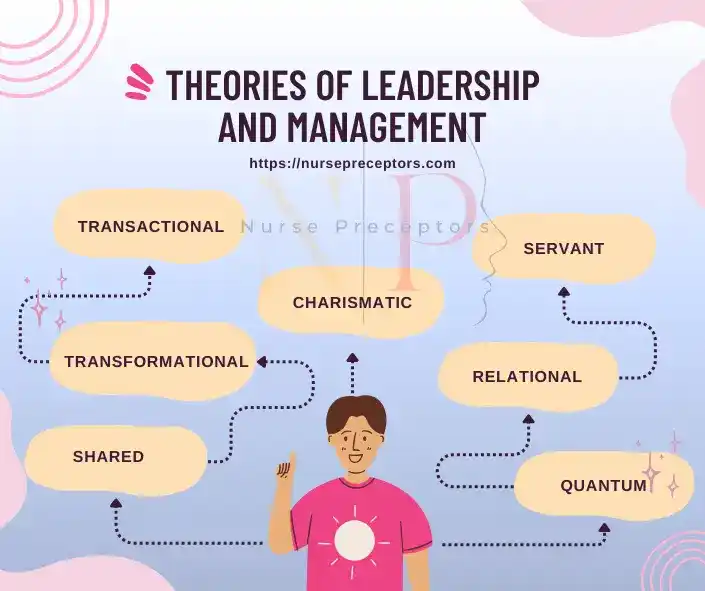
7 Approaches of effective leadership and management
- Authoritarian
- Democratic
- Laissez-faire
- Situational
- Bureaucratic
- Transformational
- Servant
Each of these leadership and management approaches has its unique strengths and weaknesses. The most effective leaders are those who can adapt their approach to meet the needs of their team and the particular circumstances they face.
However, the choice of leadership approach should be contingent on the organization’s culture, the nature of work, and the specific needs and characteristics of the team members.
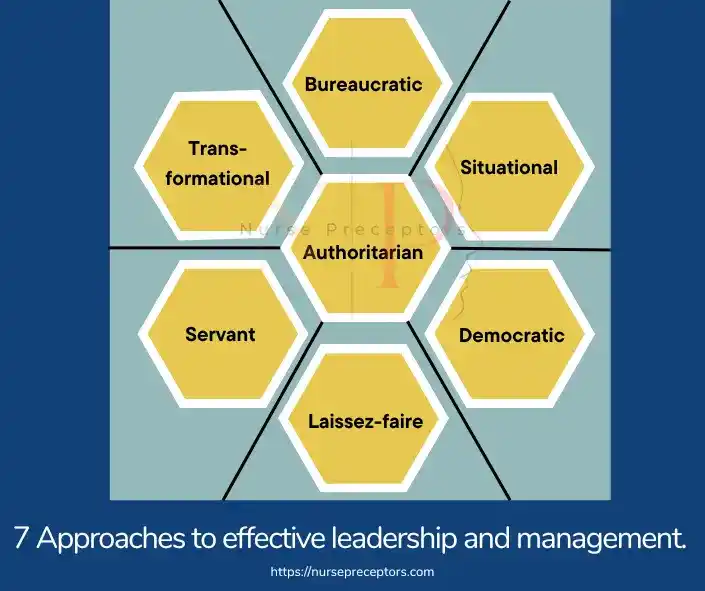
13 Distinctive leadership styles by Buchanan
The world of leadership and management is diverse and continuously evolving, largely attributed to the varying styles and approaches that leaders employ. The choice of leadership style ultimately depends on the leader’s personality, the nature of the team they’re leading, and the specific circumstances or challenges at hand.

Each of these leadership and management styles offers unique benefits and can be effective in different situations. The key is for leaders to understand these styles and adapt them to their team’s needs and organizational culture.
They should strive to create a work environment that encourages open communication, collaboration, and mutual respect, regardless of the leadership style they choose to adopt.
What are the 4 basic functions of management?
Management, as a discipline, is fundamentally about coordinating the various resources and processes within an organization to achieve its goals.
Four basic functions of management encompass all the activities conducted by managers to ensure effective and efficient operations. These functions are:
- Planning
- Organizing
- Directing
- Controlling.
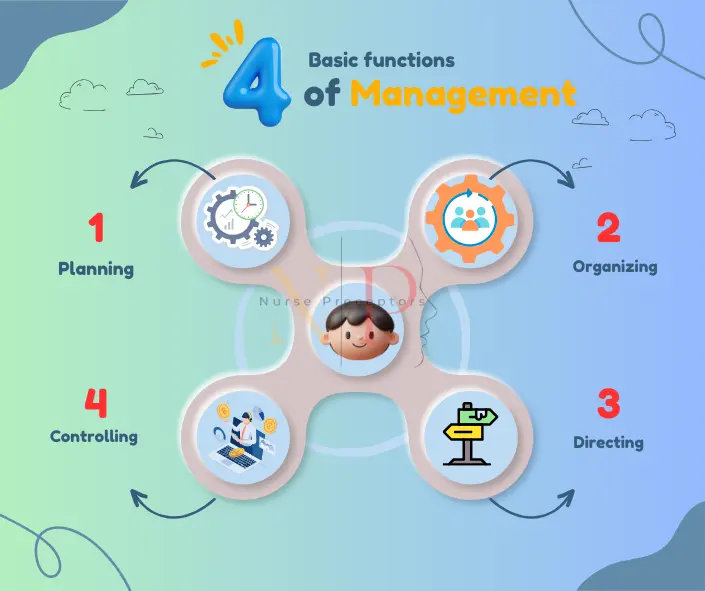
These functions provide a useful framework for thinking about management tasks and responsibilities, and they underline the importance of a balanced and systematic approach to managing organizational resources and processes.
Types of nursing management
Nursing management encompasses various administrative functions in the healthcare sector, characterized by distinct levels of responsibility and authority. The primary categories of nursing management include front-line, middle, and nurse executive positions.
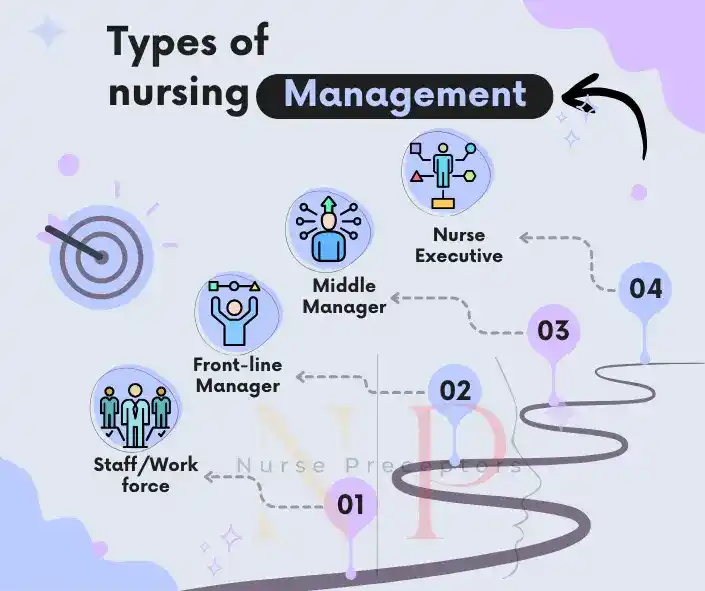
Behaviors and Qualities of Effective Leader and Manager
The behaviors and qualities of an effective leader and manager are fundamental in steering an organization toward success. These behaviors and qualities are not just about achieving targets and meeting goals, but they are the embodiment of positive values that foster a conducive working environment for every team member.
Behaviors
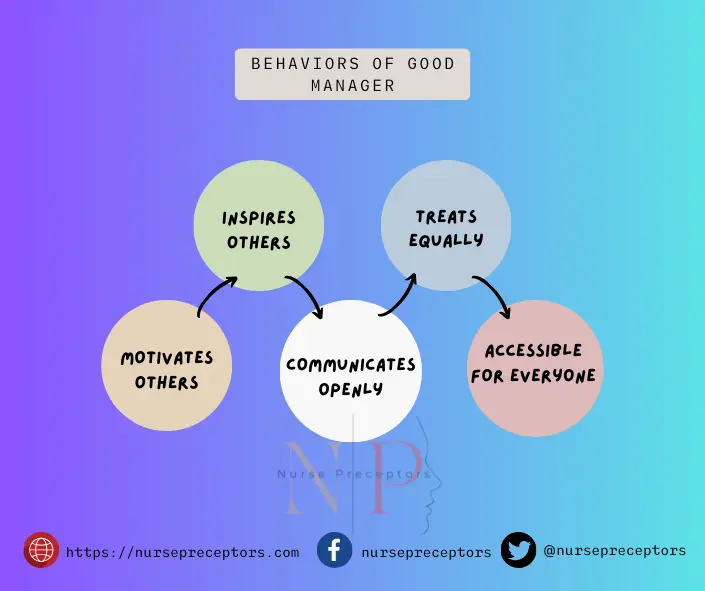
Qualities
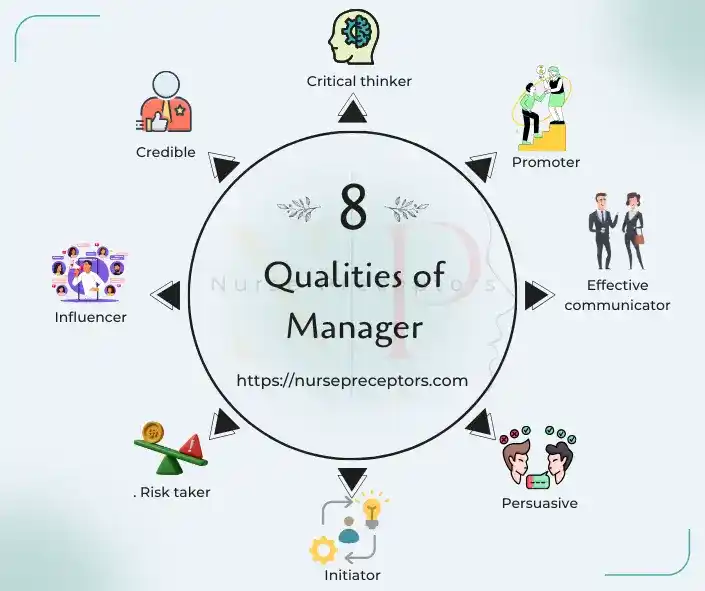
These qualities and behaviors not only contribute to individual success but also to the overall success of the organization. Therefore, organizations should prioritize developing these qualities in their leaders and managers.
Problem solving and decision making process in nursing management
Problem solving and decision making are integral components of nursing management. These skills are crucial for delivering quality care, coordinating with other healthcare professionals, and ensuring efficient management of healthcare facilities.
In an environment as dynamic and unpredictable as healthcare, the ability to effectively solve problems and make informed decisions can significantly impact patient outcomes and overall operational efficiency.
Both problem solving and decision making in nursing management should be based on evidence-based practices. Relying on scientific evidence helps ensure that solutions and decisions are effective and safe. It also promotes accountability and transparency in management practices.
Comparison and similarities of the Problem-Solving Process, Nursing Process, and the NCJMM Cognitive Skills in NCLEX-RN Exam
Problem solving, the nursing process, and the National Council of State Boards of Nursing (NCSBN) Clinical Judgment Measurement Model (NCJMM) cognitive skills all share a series of intricate similarities that are key to their effective implementation.
The NCJMM cognitive skills are key components of the NCLEX-RN exam. These skills refer to a nurse’s ability to understand, apply, analyze, synthesize, and evaluate information related to patient care.
The nursing process, on the other hand, is a systematic method that involves five steps: assessment, diagnosis, planning, implementation, and evaluation.
The phases of the problem solving process are similar to the nursing process. Understanding the nursing process and problem solving are crucial for a comprehensive understanding of NCJMM cognitive skills for CLEX-RN Exam success.
5 Steps of the Nursing Process
- Assessment
- Diagnosis
- Planning
- Implementation
- Evaluation
5 Steps of Problem Solving
- Assessment
- Diagnosis
- Planning
- Implementation
- Evaluation
6 Steps of NCJMM Cognitive Skills
- Recognize Cues
- Analyze Cues
- Prioritize Hypotheses
- Generate Solutions
- Take Action
- Evaluate Outcomes
| Nursing Process | Problem-Solving | NCJMM Cognitive Skills |
|---|---|---|
| 1. Assessment | 1. Assessment | 1. Recognize Cues |
| 2. Diagnosis | 2. Diagnosis | 2. Analyze Cue and Prioritize Hypotheses |
| 3. Planning | 3. Planning | 3. Generate Solutions |
| 4. Implementation | 4. Implementation | 4. Take Action |
| 5. Evaluation | 5. Evaluation | 5. Evaluate Outcomes |
Conclusion
In conclusion, effective leadership and management are integral components for the success of any organization. They play a crucial role in achieving strategic objectives, fostering a positive work culture, and driving performance.
Leadership and management go hand in hand- while leadership is about inspiring and motivating employees toward a common goal, management is about planning, organizing, and coordinating resources to achieve these goals.
Effective leadership and management require a combination of skills such as strategic thinking, communication, decision-making, and problem-solving.
A great leader inspires their team to reach new heights, while an efficient manager ensures the path to these heights is clear of any obstacles. In essence, leadership is about people while management is about processes.